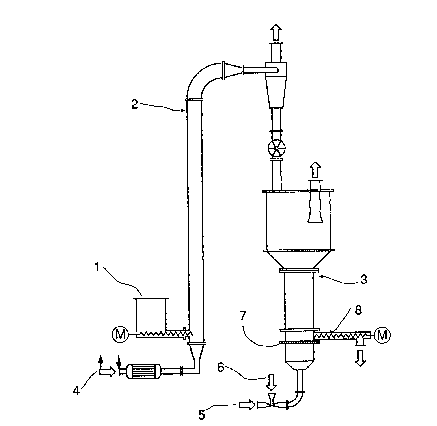Une partie des informations de ce site Web a été fournie par des sources externes. Le gouvernement du Canada n'assume aucune responsabilité concernant la précision, l'actualité ou la fiabilité des informations fournies par les sources externes. Les utilisateurs qui désirent employer cette information devraient consulter directement la source des informations. Le contenu fourni par les sources externes n'est pas assujetti aux exigences sur les langues officielles, la protection des renseignements personnels et l'accessibilité.
L'apparition de différences dans le texte et l'image des Revendications et de l'Abrégé dépend du moment auquel le document est publié. Les textes des Revendications et de l'Abrégé sont affichés :
| (12) Demande de brevet: | (11) CA 2061175 |
|---|---|
| (54) Titre français: | SECHAGE DE POLYMERES DE STYRENE EXTENSIBLES, FINEMENT DIVISES |
| (54) Titre anglais: | DRYING OF FINELY DIVIDED, EXPANDABLE STYRENE POLYMERS |
| Statut: | Réputée abandonnée et au-delà du délai pour le rétablissement - en attente de la réponse à l’avis de communication rejetée |
| (51) Classification internationale des brevets (CIB): |
|
|---|---|
| (72) Inventeurs : |
|
| (73) Titulaires : |
|
| (71) Demandeurs : | |
| (74) Agent: | ROBIC AGENCE PI S.E.C./ROBIC IP AGENCY LP |
| (74) Co-agent: | |
| (45) Délivré: | |
| (22) Date de dépôt: | 1992-02-13 |
| (41) Mise à la disponibilité du public: | 1992-08-15 |
| Licence disponible: | S.O. |
| Cédé au domaine public: | S.O. |
| (25) Langue des documents déposés: | Anglais |
| Traité de coopération en matière de brevets (PCT): | Non |
|---|
| (30) Données de priorité de la demande: | ||||||
|---|---|---|---|---|---|---|
|
O.Z. 0050/42214
Abstract of the Disclosure: In order to dry finely
divided, expandable styrene polymers having a particle
size of from 0.02 to 3 mm, the bead polymers, in the form
of a slurry in water, are freed from the majority of the
water and subsequently exposed to a gaseous medium. The
drying is carried out in two steps, by jointly conveying
the bead polymer and a first gas stream, warmed to from
about 45° to 120°C, through a flow dryer, the ratio
between the gas and the bead polymer being from 2 to 40
kg/kg, separating the bead polymer from the first gas
stream, immediately transferring the bead polymer into a
fluidized bed and treating the polymer with a second gas
stream at from about 0° to 75°C. Styrene polymers ob-
tained in this way are free-flowing and can be foamed
without difficulty in commercially available prefoaming
units. They are used, inter alia, in the construction
industry, for example as aggregate for insulation
plaster.
Note : Les revendications sont présentées dans la langue officielle dans laquelle elles ont été soumises.
Note : Les descriptions sont présentées dans la langue officielle dans laquelle elles ont été soumises.

2024-08-01 : Dans le cadre de la transition vers les Brevets de nouvelle génération (BNG), la base de données sur les brevets canadiens (BDBC) contient désormais un Historique d'événement plus détaillé, qui reproduit le Journal des événements de notre nouvelle solution interne.
Veuillez noter que les événements débutant par « Inactive : » se réfèrent à des événements qui ne sont plus utilisés dans notre nouvelle solution interne.
Pour une meilleure compréhension de l'état de la demande ou brevet qui figure sur cette page, la rubrique Mise en garde , et les descriptions de Brevet , Historique d'événement , Taxes périodiques et Historique des paiements devraient être consultées.
| Description | Date |
|---|---|
| Inactive : CIB de MCD | 2006-03-11 |
| Inactive : CIB de MCD | 2006-03-11 |
| Inactive : CIB de MCD | 2006-03-11 |
| Inactive : CIB de MCD | 2006-03-11 |
| Demande non rétablie avant l'échéance | 2000-02-14 |
| Le délai pour l'annulation est expiré | 2000-02-14 |
| Inactive : Renseign. sur l'état - Complets dès date d'ent. journ. | 1999-03-31 |
| Inactive : Abandon.-RE+surtaxe impayées-Corr envoyée | 1999-02-15 |
| Réputée abandonnée - omission de répondre à un avis sur les taxes pour le maintien en état | 1999-02-15 |
| Demande publiée (accessible au public) | 1992-08-15 |
| Date d'abandonnement | Raison | Date de rétablissement |
|---|---|---|
| 1999-02-15 |
Le dernier paiement a été reçu le
Avis : Si le paiement en totalité n'a pas été reçu au plus tard à la date indiquée, une taxe supplémentaire peut être imposée, soit une des taxes suivantes :
Veuillez vous référer à la page web des taxes sur les brevets de l'OPIC pour voir tous les montants actuels des taxes.
| Type de taxes | Anniversaire | Échéance | Date payée |
|---|---|---|---|
| TM (demande, 6e anniv.) - générale | 06 | 1998-02-13 | 1998-02-02 |
| TM (demande, 2e anniv.) - générale | 02 | 1994-02-14 |
Les titulaires actuels et antérieures au dossier sont affichés en ordre alphabétique.
| Titulaires actuels au dossier |
|---|
| BASF AKTIENGESELLSCHAFT |
| Titulaires antérieures au dossier |
|---|
| KLAUS HAHN |
| MATTHIAS DIETRICH |